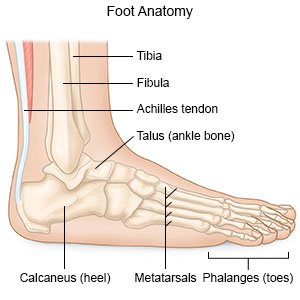Foot Fracture in Children
Medically reviewed by Drugs.com. Last updated on Aug 4, 2025.
AMBULATORY CARE:
A foot fracture
is a break in a bone in your child's foot.
 |
Common signs and symptoms:
- Pain and swelling in the injured foot
- Decreased ability to move the foot or walk
- Bruising or open breaks in the skin of the injured foot
- A different shape to your child's foot
Seek care immediately if:
- Your child has increased pain that does not go away even after he or she takes pain medicine.
- Your child's cast breaks or is damaged.
- Your child's leg or toes feel numb.
- Your child's skin or toenails become swollen, cold, or turn white or blue.
- Blood soaks through your child's splint or cast.
Call your child's doctor or bone specialist if:
- Your child has a fever.
- Your child's cast has new blood stains or a foul smell.
- Your child has more swelling than before a cast or splint was put on.
- You have questions or concerns about your child's condition or care.
Treatment
may include any of the following:
- A cast or splint on your child's foot and lower leg will prevent movement and help the foot heal.
- Medicines may be used to prevent or treat pain or a bacterial infection. Your child may need a tetanus vaccine if the skin is broken. This may be needed if your child has not had a tetanus booster in the past 5 to 10 years.
- Surgery may be used to return bones to their normal positions. Wires or screws may be used to hold the bones in place.
Cast or splint care:
- Ask when it is okay for your child to take a bath or shower. Do not let the cast or splint get wet. Before your child bathes, cover the cast or splint with a plastic bag. Tape the bag to your child's skin above the splint to seal out water. Have your child keep his or her foot out of the water in case the bag leaks.
- Check the skin around your child's cast or splint daily for any redness or open areas.
- Do not let your child use a sharp or pointed object to scratch skin under the cast.
- Do not remove your child's splint unless his or her healthcare provider or bone specialist says it is okay.
Help your child's foot heal:
- Have your child rest his or her foot and avoid activities that cause pain.
- Apply ice to decrease swelling and pain, and to prevent tissue damage. Use an ice pack, or put crushed ice in a plastic bag. Cover it with a towel before you apply it to your child's foot. Use ice for 15 to 20 minutes every hour or as directed.
- Elevate your child's foot above the level of his or her heart as often as you can. This will help decrease swelling and pain. Prop the foot on pillows or blankets to keep it elevated comfortably.

Assistive devices:
Your child may be given a hard-soled shoe to wear while the foot is healing. He or she also may need to use crutches to help him or her walk while the foot heals. It is important to use your crutches correctly. Ask for more information about how to use crutches.
Follow up with your child's doctor or bone specialist as directed:
Write down your questions so you remember to ask them during your visits.
© Copyright Merative 2025 Information is for End User's use only and may not be sold, redistributed or otherwise used for commercial purposes.
The above information is an educational aid only. It is not intended as medical advice for individual conditions or treatments. Talk to your doctor, nurse or pharmacist before following any medical regimen to see if it is safe and effective for you.
Learn more about Foot Fracture
Care guides
Further information
Always consult your healthcare provider to ensure the information displayed on this page applies to your personal circumstances.
